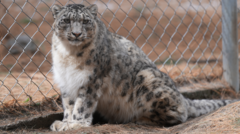In the rugged mountains of Gilgit-Baltistan, Pakistan, a new initiative is hoping to shield the majestic snow leopard from extinction. With numbers dwindling and a population ranging between 4,000 to 6,000 worldwide, conservationists are employing innovative technology to safeguard these elusive big cats. Among them is "Lovely," an orphaned snow leopard who, after being rescued twelve years ago, cannot return to the wild.
Each year, between 221 to 450 snow leopards fall victim to human-wildlife conflict as they are hunted in retaliation for livestock predation. The World Wide Fund for Nature (WWF) estimates that this has led to a 20% decline in their global population over the last two decades. In Pakistan alone, the snow leopard population is around 300, making it the third-largest group in the world.
To tackle this issue, WWF has partnered with the Lahore University of Management Sciences (LUMS) to deploy artificial intelligence (AI)-enabled cameras, designed to detect the presence of snow leopards. These rugged devices, powered by solar energy, send text alerts to villagers, advising them to move their livestock to safer locations.
Conservationist Asif Iqbal, involved in this project, showcases the functioning of these high-tech cameras, which can differentiate between humans and snow leopards. Initial trials of ten cameras have begun across three villages, showcasing the potential of AI to assist in wildlife monitoring.
Despite the technological advancements, community acceptance proves challenging. Some villagers have exhibited skepticism towards the project's potential benefits, disregarding the text alerts. One local farmer voiced concern over significant livestock losses during previous years, exacerbated by climate change as high temperatures push livestock—and their keepers—into snow leopards' territories.
Local women’s privacy is also a complicating factor; camera placements had to be adjusted to respect cultural norms. Moreover, several villages have yet to consent to the camera installation, hindering broader implementation.
With legal measures having proven effective in curbing poaching, WWF acknowledges that the AI camera initiative cannot solve these issues alone. Plans to introduce additional deterrents like smells, sounds, and lights to keep snow leopards away from villages are set for trial in the near future. The future of the snow leopards depends on a combination of technology, education, and community engagement to ensure a balance between wildlife conservation and local livelihoods.
Each year, between 221 to 450 snow leopards fall victim to human-wildlife conflict as they are hunted in retaliation for livestock predation. The World Wide Fund for Nature (WWF) estimates that this has led to a 20% decline in their global population over the last two decades. In Pakistan alone, the snow leopard population is around 300, making it the third-largest group in the world.
To tackle this issue, WWF has partnered with the Lahore University of Management Sciences (LUMS) to deploy artificial intelligence (AI)-enabled cameras, designed to detect the presence of snow leopards. These rugged devices, powered by solar energy, send text alerts to villagers, advising them to move their livestock to safer locations.
Conservationist Asif Iqbal, involved in this project, showcases the functioning of these high-tech cameras, which can differentiate between humans and snow leopards. Initial trials of ten cameras have begun across three villages, showcasing the potential of AI to assist in wildlife monitoring.
Despite the technological advancements, community acceptance proves challenging. Some villagers have exhibited skepticism towards the project's potential benefits, disregarding the text alerts. One local farmer voiced concern over significant livestock losses during previous years, exacerbated by climate change as high temperatures push livestock—and their keepers—into snow leopards' territories.
Local women’s privacy is also a complicating factor; camera placements had to be adjusted to respect cultural norms. Moreover, several villages have yet to consent to the camera installation, hindering broader implementation.
With legal measures having proven effective in curbing poaching, WWF acknowledges that the AI camera initiative cannot solve these issues alone. Plans to introduce additional deterrents like smells, sounds, and lights to keep snow leopards away from villages are set for trial in the near future. The future of the snow leopards depends on a combination of technology, education, and community engagement to ensure a balance between wildlife conservation and local livelihoods.






















